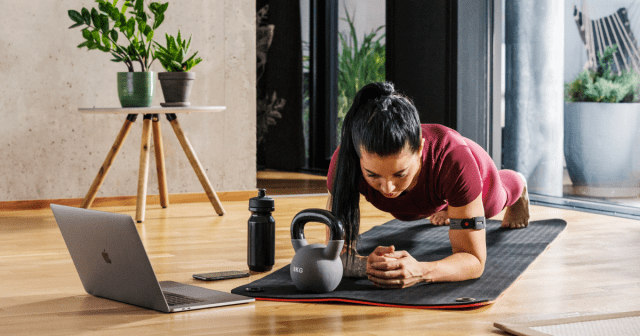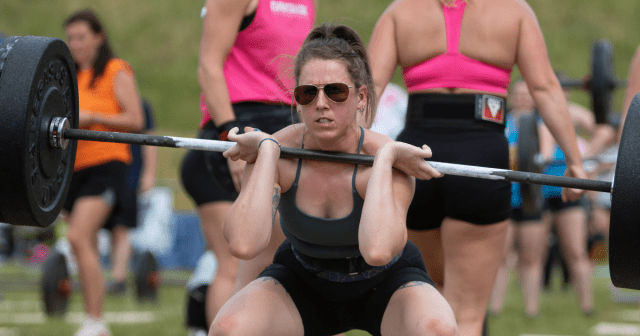As the workout mantra goes: eat, sleep, train, repeat. And yet, chances are you’ll wake up unable to walk after a leg day but feel like you should keep exercising. Work the soreness out, right?
Well, not so fast. Prioritizing muscle recovery time in your workout schedule is essential. Yes, quality sleep is a big part of this, but understanding what happens to your muscles when you exercise will help you know why it’s essential to factor in time for your recovery.
In this blog, we’ll look at how exercise and recovery build muscle, what types of training require more recovery, different approaches, foods, and drinks to aid recovery, plus how wearable tech can tell when you’re ready for more.
Why do we need to allow time for muscle recovery?
Every type of workout places stress on your body, and the tougher the challenge, the more your muscles have to handle. From lifting hefty weights in the gym to finally nailing Bhairavasana pose in yoga, there are many ways you can cause your muscles to feel tired from exercise.
When you do something new or to a new level of intensity with your muscles, you cause microscopic tears to occur in the muscle fibers. But far from being a cause for concern, this ‘damage’ is, in fact, positive – as long as you allow enough time for your body to heal.
This process of working out and then recovering is how you build muscle, reduce inflammation, and improve your insulin sensitivity and cardiovascular health. It occurs because your body’s tissues (such as your muscles, lungs, heart, and bones) are able to repair this damage, which means the next time you do the same exercise, they’ll be ready for it. Repeated over time, this process of stress + recovery = how you become a healthier, fitter person.
That’s why it’s important to place as much emphasis on recovery as you do on exercise. If not, you’ll quickly burn out and may even injure yourself through overtraining. Additionally, inadequate rest and recovery can lead to other health issues, such as poor immunity, hormonal issues, and depression.
So, taking time for muscle recovery is essential for the rebuilding and strengthening process. But just how much time should you allow?
How long does muscle recovery take?
Your muscle recovery time depends on you and what type of exercise you’re doing. Certain factors like your fitness level, exercise history, workout intensity, and duration will all influence how much recovery time you need. That means listening to your body and tracking your recovery will be the best way to tell when you’re recovered and ready for another workout.
Certain factors like your fitness level, exercise history, workout intensity, and duration will all influence how much recovery time you need.
If you’re doing light workouts and paying attention to your body, you may only need minimal recovery time aside from prioritizing sleep each night. With this approach to exercise, you can probably work out most days but should always give yourself at least one day off each week.
If you’re doing moderate to intense exercise, you must take a couple of days off. At least one, if not two, after a challenging workout. A study from the Journal of Strength and Conditioning Research found that three days are required for your muscles to fully recover after an intense strength-training session. So, again, it’s essential to pay attention to how far you’re pushing yourself and how your body feels afterward.
It’s also important to know that when you’re experiencing stress in your daily life, you’ll also need to factor in more muscle recovery time. A separate study from the same publication found that stress levels and recovery times are linked, with increased stress leading to a slower recovery, while less stress saw a faster recovery window. So, focussing on techniques for managing your stress on rest days is also a positive approach for improving your recovery.
What helps muscle recovery?
Many different recovery approaches will help you process and benefit from your workouts. You can include any of these types of recovery in your exercise plan, depending on what workouts you do and when, to ensure your body is always in peak condition. However, it’s also important to note that you’re meant to follow only some of them all the time rather than seeing this as a checklist to complete every time.
Sleep
Sleep is essential to recovery, especially for strength training, as it’s integral for muscle growth. Research has found that sleep deprivation can impair your body’s inflammation reaction and production of muscle growth hormones. That means poor sleep = poor muscle recovery. So, this form of recovery should be a priority at the end of every workout day.
The more you exercise, the more importance you should place on sleep. Rather than trying to sleep for longer, you should focus on sleeping better, such as maintaining regular sleep/wake times.
Passive recovery
As the name suggests, passive recovery is when you give your body a complete break, doing as little physical exertion as possible. A recovery session like this might be relaxing with a book, watching TV, or doing anything that makes you feel chilled out.
Active recovery
While it may seem contradictory initially, active recovery is when you do light exercise the day after an intense workout. It helps increase blood flow to your muscles, helping them to recover faster and better. A recovery session like this might look like gentle yoga, walking, or swimming.
A recovery run is a particularly great form of active recovery if you’ve done an intense run or a marathon the day before. Pick somewhere flat, as you don’t want any challenging hills, a go for a short run at a slow, relaxed pace. Include some stretches and plenty of fluids; your muscles will thank you.
Myofascial Release
Often referred to as soft tissue therapy, this form of recovery includes massage and foam rolling. It’s very popular with athletes trying to decrease the impact of muscle soreness and reduce their recovery window. A recent review of studies found that massage has a small but significant effect on reducing this soreness and improving flexibility after exercise.
Compression garments
Another popular form of recovery among athletes involves wearing form-fitting clothing (often made out of elastin and nylon) to increase blood flow to muscles affected by your workouts.
Socks and shorts are among the most popular forms of compression garments. While there have been limited studies into their effectiveness, many athletes find they reduce the time required for muscle recovery.
Cold and heat therapies
This form of recovery involves a variety of different techniques involving water temperature. For some, this looks like a cold shower after a workout. For others, it could be cryotherapy or alternating between warm and cold water.
There have been a variety of research into the effectiveness of these different types of therapy, with many pointing toward the significance of cold and heat therapies in reducing muscle soreness and overall tiredness after intense exercise.
What to eat for muscle recovery
Eating healthy food is essential for muscle recovery. Without the proper diet, your body will lack the necessary nutrients to repair and develop muscle mass.
Macro eating, which includes a balance of carbohydrates, proteins, and fats, is a great way to ensure your body is fuelled for recovery and primed for building bulk.
There are three critical times of day when you can boost your capacity for muscle recovery with food, especially if you’re doing any form of strength training:
- Pre-workout: a small protein snack before you exercise can help increase your muscle protein synthesis, which is vital for maintaining and building muscle. Opt for something easy to digest, like a hard-boiled egg, nuts, or greek yogurt. However, don’t overeat, or you could work out with an upset stomach.
- Post-workout: protein and carbohydrates should be your go-to meal after exercise. Protein will enhance your capacity to repair muscle damage, and carbs will top up the glycogen stores in your muscles, your primary energy source, which are depleted during intense workouts. Eat something that mixes complex carbohydrates like quinoa, brown rice, or whole wheat bread with a healthy protein option like tofu, fish, or beans.
- Before bed: studies have shown that a small protein snack before bed can also positively affect your muscle protein synthesis. Again, go for one of the light, easily-digestible suggestions above and consume it at least 30 minutes before bed so that your stomach isn’t trying to process this food while you sleep.
What to drink for muscle recovery
Staying hydrated is also essential for muscle recovery. Your body requires a lot of water to build the proteins in muscle tissue. Otherwise, they’ll have a diminished ability to repair themselves. So, pay attention to your hydration, especially when working out in hot or humid weather.
Your body requires a lot of water to build the proteins in muscle tissue.
Sports drinks are an excellent option for any type of endurance event, like a marathon, as they help replenish electrolytes (which contribute towards muscle repair) that you lose through sweat. However, it’s important to remember that such drinks contain a large amount of sugar (to help your body rapidly absorb these electrolytes), so it’s best to consume them when such high-intensity challenges require such support.
Another drink that can boost muscle recovery is tart cherry juice. Studies have shown that this juice has both antioxidant and anti-inflammatory properties, which can accelerate recovery and reduce muscle soreness. Interestingly, to benefit from tart cherry juice, you should consume it 4-5 days before an event and 2-3 days afterward.
As mentioned above, consuming protein before and after a workout can significantly assist with the recovery process. Drinking chocolate milk (of both the cow and soy varieties) is another excellent option for this easily-digestible protein boost. Studies have shown that it can even decrease muscle soreness and recovery time, so you’ll be ready sooner for your next workout.
Monitoring recovery
While listening to your body is an integral part of the recovery process, monitoring it can also provide valuable insights. Wearable tech is an easy and insightful way to understand how your body is after a workout and how soon you’ll be ready to go again.
Polar’s Training Load Pro is a quick way to tell if you’re pushing yourself too much (or not enough). The Cardio Load status provides a rating for your overall recent exercise, measuring your strain vs. tolerance to let you know if your training has been productive or overreaching.
Are you ready for high-intensity training? Polar’s Leg Recovery Test has the answer. This simple fitness assessment can tell if your leg muscles have the necessary power for this type of workout by comparing it with your 28-day average. Plus, this test has been backed by a recent study, confirming its effectiveness. So, now you can simply jump to see if you’ve bounced back.
Conclusion: muscle recovery
As we have seen, factoring in time for your recovery is essential to any training schedule.
Here are some of the key points covered in this blog:
- Exercise causes ‘healthy’ damage to your muscles, and recovery time to repair this is necessary for building muscle.
- Light workouts usually only require good sleep, while intense workouts may require a few days of recovery.
- Stress can cause your recovery time to be longer.
- Quality sleep, passive and active recovery, massage, foam rolling, compression garments, plus hot and cold therapies are all good for muscle recovery.
- Macro eating and good hydration will give you the necessary nutrients for a faster recovery.
- Monitoring your training with wearable tech can also provide you with the necessary insights into your recovery status.
Remember, the harder you push your muscles, the longer you’ll need to recover. So, make sure you get the most out of what you put in by allowing time to rest and repair – then get ready to go again.
If you liked this post, don’t forget to share so that others can find it, too.
Or give it a thumbs up!
I like this article
Please note that the information provided in the Polar Blog articles cannot replace individual advice from health professionals. Please consult your physician before starting a new fitness program.





